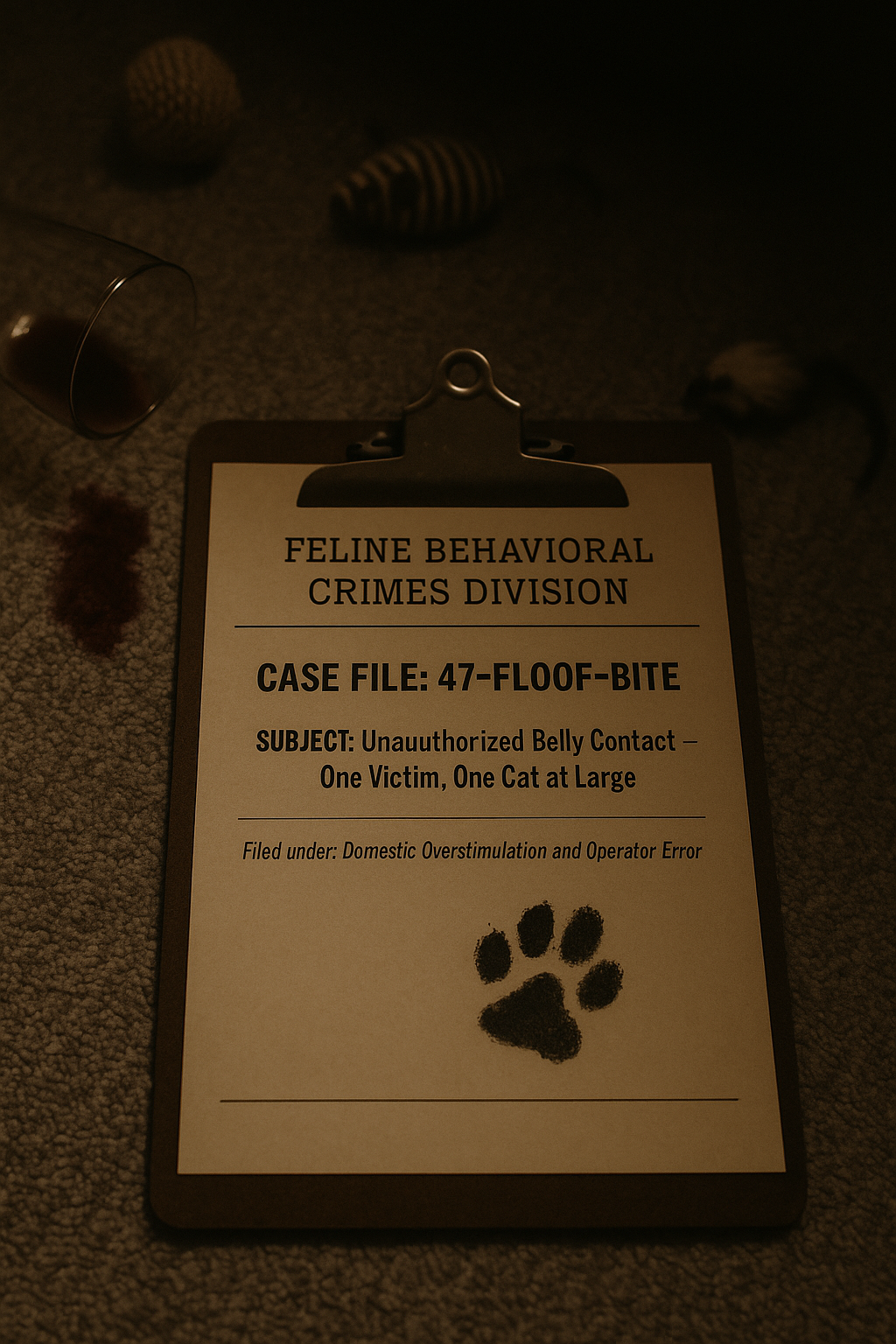How to Avoid Getting Chomped
Suspect: Pickles. Charges pending. This image was created digitally.
FELINE BEHAVIORAL CRIMES DIVISION: Unauthorized Belly Contact
Filed under: Domestic Overstimulation and Operator Error
Location: Living room sofa
Victim: Shelia, female human, superficial punctures
Suspect: Pickles, DLH, neutered male, two years old, no prior incidents. Known Associates include a catnip mousie and an unreliable laser pointer. Refused to cooperate with questioning.
Scene Summary:
Scene: one human clutching hand and arm injury, blood droplets on the floor. Feline suspect remains at large on the dining room table, washing his paws and face.
Preliminary conclusion: someone made the rookie mistake of touching the forbidden belly floof.
*This image was created digitally.
ALVAREZ: Looks like a classic case of premature belly contact.
SHAW: Of course the “Victim” swears she was invited.
ALVAREZ: Roll-over posture misread again. Happens every week.
SHELIA (off-camera): She rolled over and did a big stretch! She trusts me!
SHAW: Trust isn’t consent. Tempting the human with the primordial pouch is a risky business. Time to do community outreach and education.
SHAW and ALVAREZ approach SHELIA.
ALVAREZ: Let’s review the prevention protocol, Shelia.
SHELIA: This came out of nowhere! It’s like he went psycho!
ALVAREZ: Never engage the belly floof unless you’ve got a written invitation. Consider that a restricted zone.
SHELIA: But he likes it sometimes!
SHAW: Temporal variance isn’t consent.
ALVAREZ: Step two: watch for early-warning signs: tail flicks, ear rotation, pupil dilation.
SHAW: Visual warnings ignored are the leading cause of minor hand trauma.
ALVAREZ: Step three: no hand-to-paw combat. The suspect’s claws hold jurisdiction. The number one reason most hand injuries occur is human operator error.
SHAW: Shelia, your hand is not an appropriate toy.
ALVAREZ: Step four: deploy enrichment toys to redirect predatory impulses. Step five: no finger-waving near an excited cat. That’s a major trigger.
SHEILA: She wanted me to. He looked right at me and his little paws were curled and so cute! He asked me to, I swear!
ALVAREZ: Ma’am, the record will show the suspect’s paw position is not legally binding.
SHAW: Prey drive activated, target acquired. Don’t do something you’ll both regret.
ALVAREZ: Step six: ask for permission. Initiate cheek or head contact only when the cat invites it.
SHELIA: He was purring! He licked my hand!
SHAW: Shelia, if you’re in any way unsure, don’t touch the suspect.
[Interrogation Room — 22:10 hours]
Pickles sits on the table, tail flicking once every two seconds. A water dish has been provided but remains untouched.
ALVAREZ: You understand why you’re here, right?
(Pickles takes a long look around the room, ignoring the interrogators.)
ALVAREZ: Don’t play innocent. Witnesses place you mid-couch, pre-bite. Motive looks personal.
(Pickles grooms left paw. No verbal response.)
SHAW: Easy, Detective. He’s showing displacement behavior. Self-grooming to regulate his emotions.
(Pickles turns, presenting his back to the officers. Tail flicks increase in frequency.)
ALVAREZ: You call that regulation, I call it attitude. He’s been a bad kitty.
SHAW: Look at the ears. Half-rotation, soft tail lash. He’s stressed out. Don’t call him a bad kitty. He was the real victim here.
(Pickles pauses grooming. Flicks tail harder.)
SHAW: There! See it? Escalation cue. He’s giving us exactly what he gave the victim: three warnings.
(Pickles stretches and hops down, brushing against Shaw’s leg before leaving the room.)
ALVAREZ: So, we’re logging this as self-defense?
SHAW: Affirmative. Three non-verbal warnings got ignored.
Behavioral Analysis
In this department, we don’t deal in villains. Cat is both victim and perpetrator.
Crimes occur because humans haven’t learned how felines communicate.
Cats don’t bite out of pure meanness or revenge. They bite because every signal they sent, including but not limited to: tail flicks, ear turns, pupil shifts, and whisker position, all go unrecorded.
What looks like feline aggression is usually overstimulation. A nervous system pushed past its limit when the human life partner doesn’t observe the evidence.
When a cat’s warnings fail, the teeth file the final report.
Cats aren’t spiteful. Their nervous system gets overloaded, and they’ve run out of options. All the softer ways of body cues and vocalizations that say “time to stop, please,” have been ignored.
Learn the body language. Respect boundaries. Keep everyone, both cat and human, safe and unbandaged. Understanding cat body language and respecting feline boundaries prevents most bites before they happen.
Post-incident behavioral analysis. Case 47-FLOOF-BITE filed and closed. This image was created digitally.
Need to file your own behavioral report?
If your cat’s been handing out warning bites or purring before the ambush, we can decode the evidence together.
Book a Behavioral Consultation — no interrogation lamp required.
Case closed. All parties recovered except a band-aid or two. No grudges held. Hopefully, at least one human learned a lesson.
CASE NOTES: FIELD TAKEAWAYS
Internal Use Only
Only go for the belly floof if you’ve been granted access, given a green light, and an engraved invitation. And even then, proceed at your own risk.
Watch for the warning signs: tail flicks, twitchy ears, pupils going full-dinner-plate. Ignore them at your peril.
Never initiate hand-to-paw combat; the suspect is better armed. Spoiler: you will lose. Every time.
Redirect aggression with sanctioned toys and structured play.
Waving your fingers around an excited cat? That’s just asking to get chomped. It ignites a cat’s prey drive.
Offer cheek or head contact only when the cat initiates.



